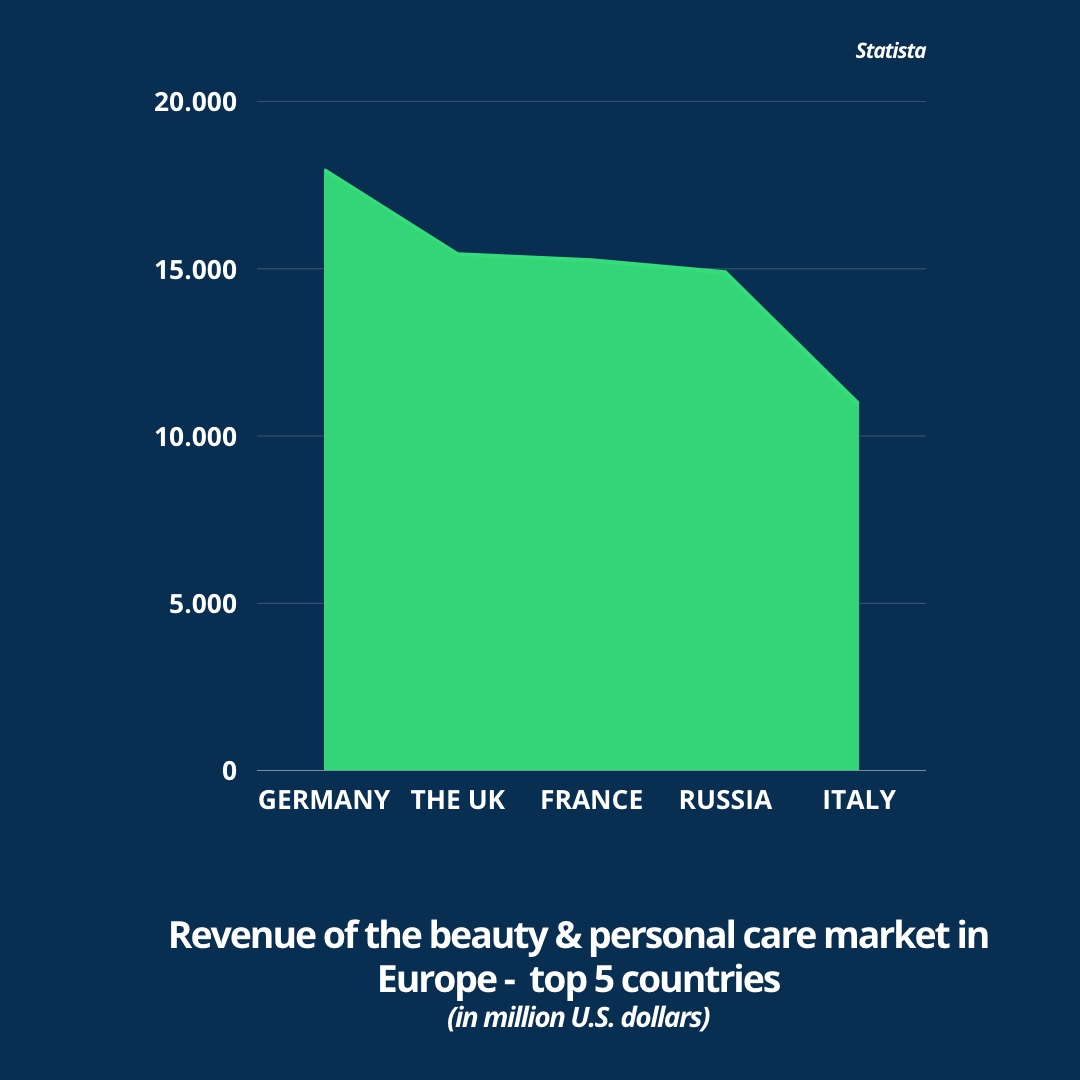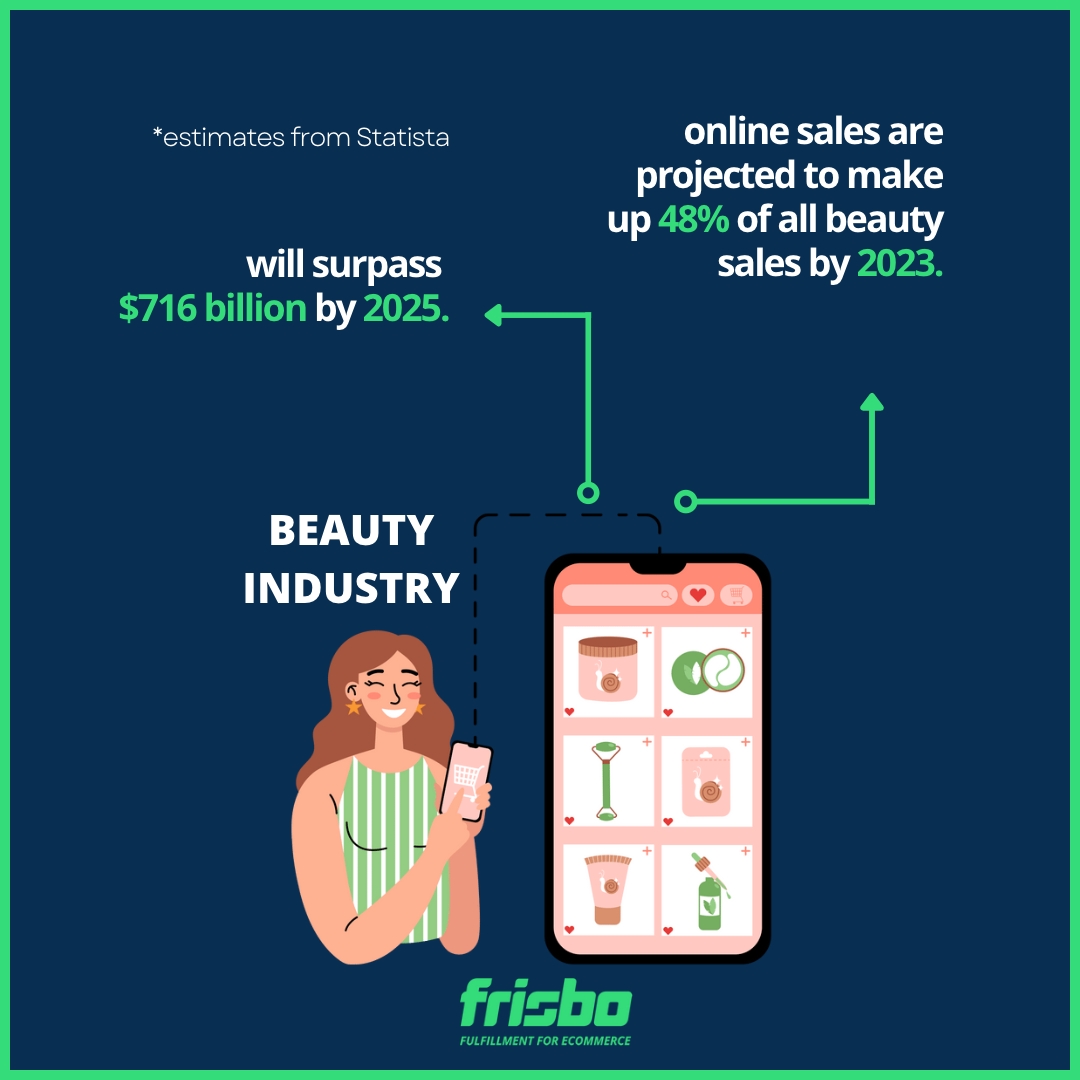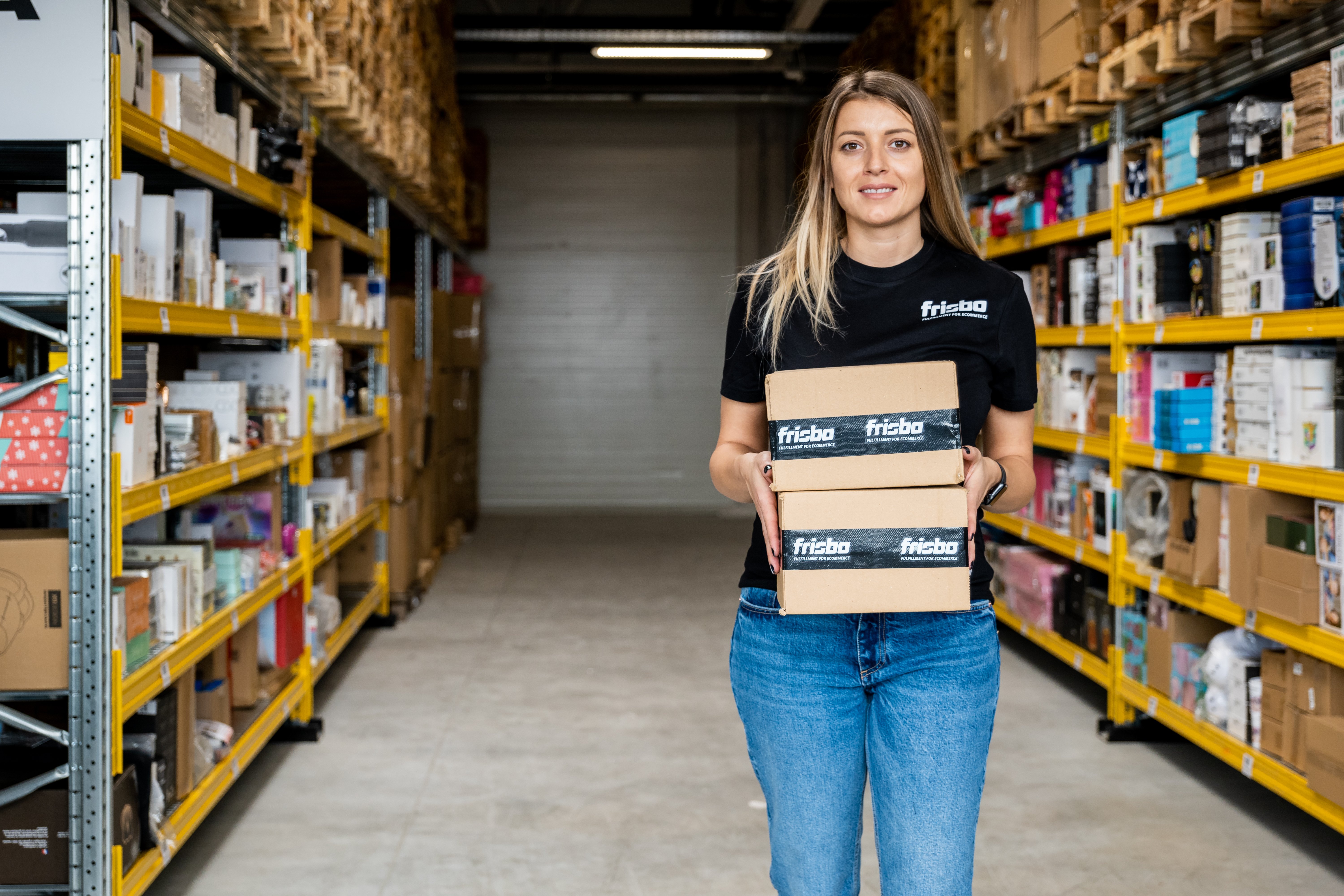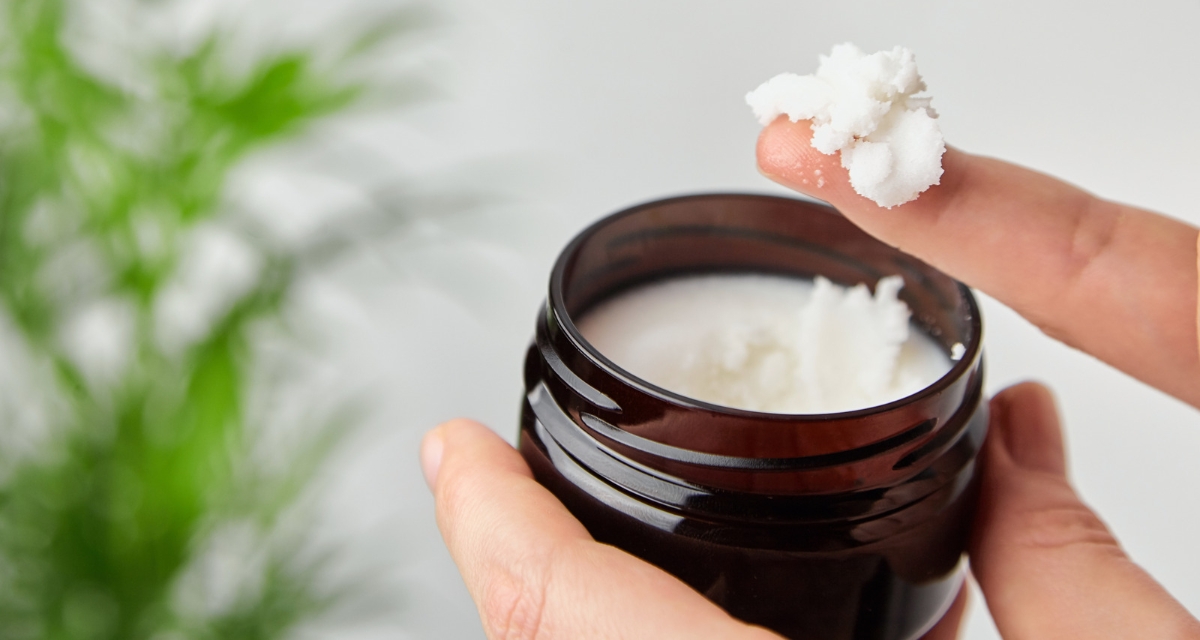With digitally-native stores proliferating quickly across social media and digital purchasing channels, e-commerce is becoming the cosmetics industry's primary source of global sales.
The demand for effective fulfillment increases as the beauty sector keeps growing. Consumers expect quick and convenient shipping options, and businesses must be able to meet these expectations to thrive in the market.
In this article, we take a closer look at the latest trends, challenges, and innovative solutions shaping the future of cosmetics fulfillment.
1. Statistics and trends in beauty e-commerce
2. Challenges of consumer cosmetics order fulfillment
3. Solutions to simplify beauty products fulfillment
Statistics and Trends in Beauty E-commerce
The e-commerce beauty sector has recently experienced a remarkable surge as an increasing number of consumers have begun purchasing their beauty products online. This shift towards online shopping has been advantageous for both consumers and businesses alike, offering a plethora of benefits.
The cosmetics electronics e-commerce industry is growing
With a global compound growth rate of 4.75%, the beauty sector is expected to surpass $784.6 billion by 2027 from $511 billion in 2021.
The math is simple. Shopping for beauty products from the comfort of their homes got very convenient and gained popularity through the development of many online sales channels, continuing to attract more and more clients willing to pay more for better quality.
As international differences in consumer behavior necessitate a customer-focused business strategy that integrates both digital and traditional retail channels, online beauty retailers who want an advantage over competitors must develop their growth strategies with their customers in mind.
Geographically speaking, according to a report published by CommonThread, the areas with the highest market share of the cosmetics market are Asia (46%), Europe (24%), and North America (24%).

Consumer data-driven product customization is on the rise
When it comes to the ever-evolving world of cosmetics, staying on top of emerging trends, ingredients, and products is essential for businesses. With the industry constantly growing in popularity, consumers are looking for products that not only align with their values and lifestyles but also reflect their unique personalities.
According to a 2018 survey by Epsilon, 80% of respondents indicated they were more likely to purchase from companies that offer personalized experiences. Today's beauty consumers seek customized interactions with brands catering to their specific needs.
As proof, Sephora, a famous direct-to-consumer brand that utilizes innovative technology to provide an exceptional personalized customer experience, is the leading name in online cosmetics e-commerce.
The focus is on natural and sustainable beauty products.
In today's market, consumers are increasingly drawn to transparent and natural brands, especially in the realm of online shopping. Beauty products made with natural and/or organic ingredients are highly sought after by customers, as they are believed to be safer and gentler on the skin.
As a result of this trend, many businesses within the beauty industry have shifted towards offering natural and organic products. To meet consumer demand, these companies place a premium on sourcing high-quality, eco-friendly ingredients and utilizing sustainable packaging. By prioritizing these factors, businesses can appeal to conscious consumers committed to sustainable practices.
The favorite marketing strategy in the online beauty sector
Influencer marketing has played a major role in beauty e-commerce strategies for the past several years and shows no signs of slowing down. In fact, the influencer marketing sector has grown significantly, from $1.7 billion in 2016 to $16.4 billion in 2022.
The use of influencers is a widely favored and successful tactic employed by businesses in the beauty industry to market their products and services. With their extensive social media reach, influencers can leverage their platform to connect with a vast audience. Many beauty companies collaborate with influencers to produce sponsored content, including sponsored posts on Instagram or YouTube videos, which showcase their products to the influencer's followers. This strategy is highly effective in reaching potential customers and expanding brand visibility.

Challenges of consumer cosmetics order fulfillment
E-commerce has revolutionized how consumers shop for beauty products, making it easier and more convenient than ever to find and purchase the products they want.
However, the growth of e-commerce has also introduced new challenges for businesses in the beauty industry, particularly regarding fulfillment. Below, we will explore some of the challenges that online beauty retailers face regarding e-commerce fulfillment, including the perishable nature of many beauty products, the need for careful handling and storage, and the need to stand out from the competition.
Beauty products make up for high SKU volumes.
A major challenge in e-commerce fulfillment for cosmetics is managing inventory. Beauty products have a wide range of SKUs (stock-keeping units) with different shades, sizes, and formulas, making it difficult to keep track of inventory and ensure that orders are fulfilled accurately.
In addition, the high demand for certain products, such as popular makeup shades or skincare products, can lead to stockouts and backorders if inventory is not managed carefully.
Employing logistics technology can help businesses keep track of inventory, no matter the number of SKUs, across multiple channels, including online marketplaces and brick-and-mortar stores, and ensure that accurate stock levels are maintained.
Cosmetics have a limited shelf life.
Managing the inventory of an online beauty store can be particularly challenging due to the perishable nature of the majority of beauty products. These products must be handled and stored carefully to preserve their quality.
In order to prevent product expiration, businesses must constantly manage their inventory levels, make sure that products are rotated, and accelerate shipping when this is the case.
The strategy for managing perishable beauty products is implementing a first-in, first-out (FIFO) system. This method involves arranging products to ensure the oldest items are sold first, reducing the risk of products expiring before they are sold. This system also enables businesses to accurately track product expiration dates and identify items that need to be discounted or removed from inventory.
Beauty products must reach your clients ASAP.
Providing fast and reliable delivery options in the highly competitive beauty industry is crucial to retain customer loyalty and satisfaction. Customers expect their orders to be delivered quickly; they may turn to competitors instead if a company cannot provide this.
Did we mention that cosmetics might be easily spoilt? Therefore, if they are not shipped and delivered quickly, beauty products can expire before they reach the final customer.
The simplest solutions include streamlining picking and packing processes, reducing handling times, and using fast and reliable delivery options. Businesses can reduce delivery times and improve overall efficiency by improving internal processes.
Fulfilling beauty products needs extra when packaging.
Packaging and branding are key factors in a customer's purchase in the beauty industry. Online beauty stores must ensure their packaging is attractive, durable, and protects the products during shipping. Here are some key factors to consider when packing beauty products for shipping:
- Use appropriate packaging materials: The packaging materials used to ship beauty products should be carefully chosen to protect the products and prevent damage during transit. This may include bubble wrap, foam sheets, other cushioning materials, and sturdy cardboard boxes or mailers.
- Include protective inserts: Protective inserts, such as foam or plastic dividers, can help keep beauty products in place and prevent them from moving around during shipping. This can reduce the risk of damage, such as broken or spilled products.
- Use proper sealing techniques: It is important to properly seal the packaging of beauty products to prevent them from opening or leaking during transit. This may involve using tape, glue, or other adhesives to securely seal the packaging.
- Consider the weight and size of the box: The weight and size of the package can impact the shipping cost and delivery time, so it is important to consider this when packing beauty products for shipping. Using lightweight and compact packaging materials can help keep the package size and weight down, saving shipping costs and reducing the risk of damage during transit.
- Include clear labeling and instructions: The packaging of beauty products should include clear labeling and instructions, such as the recipient's address and special handling instructions. This can help ensure the package is delivered to the correct destination and handled properly during transit.
Natural beauty products ask for natural and organic packaging.
As many consumers are becoming more environmentally conscious, they are looking for products and services that are sustainable and eco-friendly. Therefore, organic and sustainable packaging can be a selling point for online cosmetics stores and help differentiate the company from its competitors.
To meet this evergrowing demand, you can use packaging made from natural, biodegradable materials, such as paper, cardboard, or bioplastic. These materials are more environmentally friendly than traditional packaging materials, such as plastic, and can be easily disposed of or recycled without harming the environment. Sustainable packaging helps cosmetics online stores to reduce their environmental footprint and contribute to a more sustainable future.
Tested solutions to simplify beauty products fulfillment
The order fulfillment challenges for online beauty stores are numerous and require careful planning and implementing practical solutions. By addressing these challenges and improving their fulfillment processes, online beauty stores will eventually provide a better customer experience and retain their loyalty and satisfaction.
One of the most optimal solutions for e-commerce beauty businesses dealing with order fulfillment challenges is to consider partnering with a third-party fulfillment provider with expertise in the beauty industry who can handle beauty products' storage, handling, and shipping.
At Frisbo, we provide our clients selling cosmetics with specialized fulfillment for their personal care products, accurate pick & pack services, and next-day delivery across Europe. Here’s how we do it:
Deploying automated inventory management
To avoid the struggle of manually updating the inventory levels and prevent overstocking or running out of stock, beauty e-commerce stores use technology and automation to manage their inventory and fulfillment processes. By using software and systems to track inventory levels and fulfill orders, online stores can improve the efficiency of their operations and reduce the risk of errors.
Frisbo allows online stores to leverage automated inventory management software to efficiently manage their cosmetics products across multiple channels, including their website, physical store, and marketplaces like Amazon, Allegro, or eMag.
One integration unlocks access to 30 warehouses
Once an online store connects to Frisbo’s network, it can store its products in one or more of the 30-warehouses network. This helps any online store to reduce shipping costs, as it can choose the fulfillment closest to the customer when fulfilling an order.
Plug&Play integrations
Whether selling cosmetics via websites, marketplaces, or both, plugging sales channels into our fulfillment network is just a few clicks away. This helps the sellers to ensure that the store's systems work seamlessly together, improving the business’s overall efficiency and productivity.
Real-time inventory tracking
The vast number of SKUs are tracked in real-time to help the online retailer identify how the products are doing and any inventory issues or discrepancies. This way, the seller has a complete overview of the performance of a particular product line and can quickly address any issue to prevent disruptions to the company.
Accurate Pick&Pack services for cosmetics
Pick&Pack services are essential for cosmetics because these products are often delicate and require special handling to prevent damage. Moreover, cosmetics are often subject to regulations and safety standards, and Pick&Pack helps the e-commerce seller to ensure that these requirements are met.
Micro-fulfillment strategies for cosmetics fulfillment
At Frisbo, we assist cosmetics sellers in adapting to evolving customer preferences and market conditions, enabling them to remain on the frost line in the highly competitive beauty industry. By implementing clever micro-fulfillment strategies, online beauty stores can reach their customers the next day, wherever they are, making their products more attractive to customers.
Are you looking for a fulfillment partner for your cosmetics e-commerce business? Frisbo integrates with all major e-commerce platforms and marketplaces, giving you access to the largest fulfillment network in Europe.
Request a quotation!





